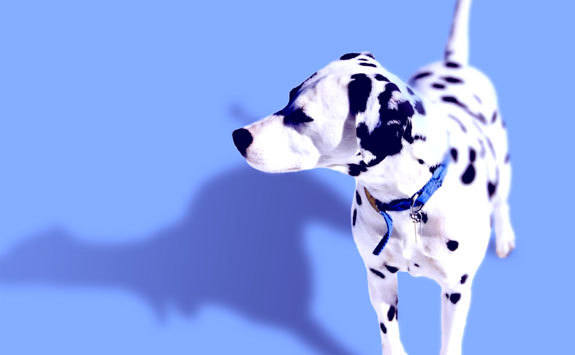Are Dogs Color Blind? How Dogs See Color

"Do dogs see in color?"
This is a question we are commonly asked at PupLife. Since dogs can't tell us if they see in color or black and white, we are forced to rely on evidence from various tests and from reports that we have read. Most scientists seem to believe that dogs are not color blind (technically). However the colors that dogs see, and the way that these colors are interpreted vary significantly from the way that colors are interpreted by humans.
How do dogs see compared to humans?
This is the key to understanding how dogs' vision differs from humans. Dogs have less cone cells in their retina than humans, so it is believed that they view colors in a lighter hue. In other words, a dark cobalt Dog Toy or Dog Bed may be viewed by dogs as a light, powder blue. So, if your dog runs past his or her toy, it might be because of the color!
There is a bit of a disagreement right now among many scientists as to how dogs see color and whether or not dogs lack the ability to see some colors (green and red are commonly mentioned). According an article on Psychology Today, Dogs See Most Colors as yellow, blue, and gray. The colors of green, yellow and orange can appear to them as yellow-ish.
This is the key to understanding how dogs' vision differs from humans. Dogs have less cone cells in their retina than humans, so it is believed that they view colors in a lighter hue. In other words, a dark cobalt Dog Toy or Dog Bed may be viewed by dogs as a light, powder blue. So, if your dog runs past his or her toy, it might be because of the color!
There is a bit of a disagreement right now among many scientists as to how dogs see color and whether or not dogs lack the ability to see some colors (green and red are commonly mentioned). According an article on Psychology Today, Dogs See Most Colors as yellow, blue, and gray. The colors of green, yellow and orange can appear to them as yellow-ish.
Many One way to determine this is to Compare How Dogs See Compared To Humans. While dogs have fewer cone cells than humans, it is thought that dogs have more Rod Cells than humans do. Rod cells are the basic blocks for a seeing in black and white. Therefore, dogs may indeed see in black and white (contrasting stripes, etc) better than humans. Also, since dogs have more rod cells, they are able to intrepet slight changes in light, helping them to see better at night. In short, dogs have better night vision than humans.
Current thought is that dogs may be slightly near-sighted (things in the distance appear blurry), and that their intrepetation of colors may be incorrect, or simply different than ours. Again, since we can't ask a dog to respond to eye vision testing (as we do when obtaining an eyeglass prescription) this can't be proven 100%. However, it is widely accepted that dogs do see better at night. The ability to see better at night is certainly an advantage and one that helps dogs a great deal.
Everytime that we have asked our dogs whether or not they are color blind, the answer that we always get (in our scientific testing) always seems to be the same: "Woof!" Until dogs can talk, we must accept the latest scientific majority opinion: dogs can see some colors (albeit differently than us) and perhaps not all. If your dog tells you differently, please let us know!
However, one thing that dogs do know is how to make eye contact with humans and interact accordingly. Our article Dogs Understand: 5 Things Your Dog Knows About You details how your pet communicates with you, in ways that you may not have ever comprehended.
